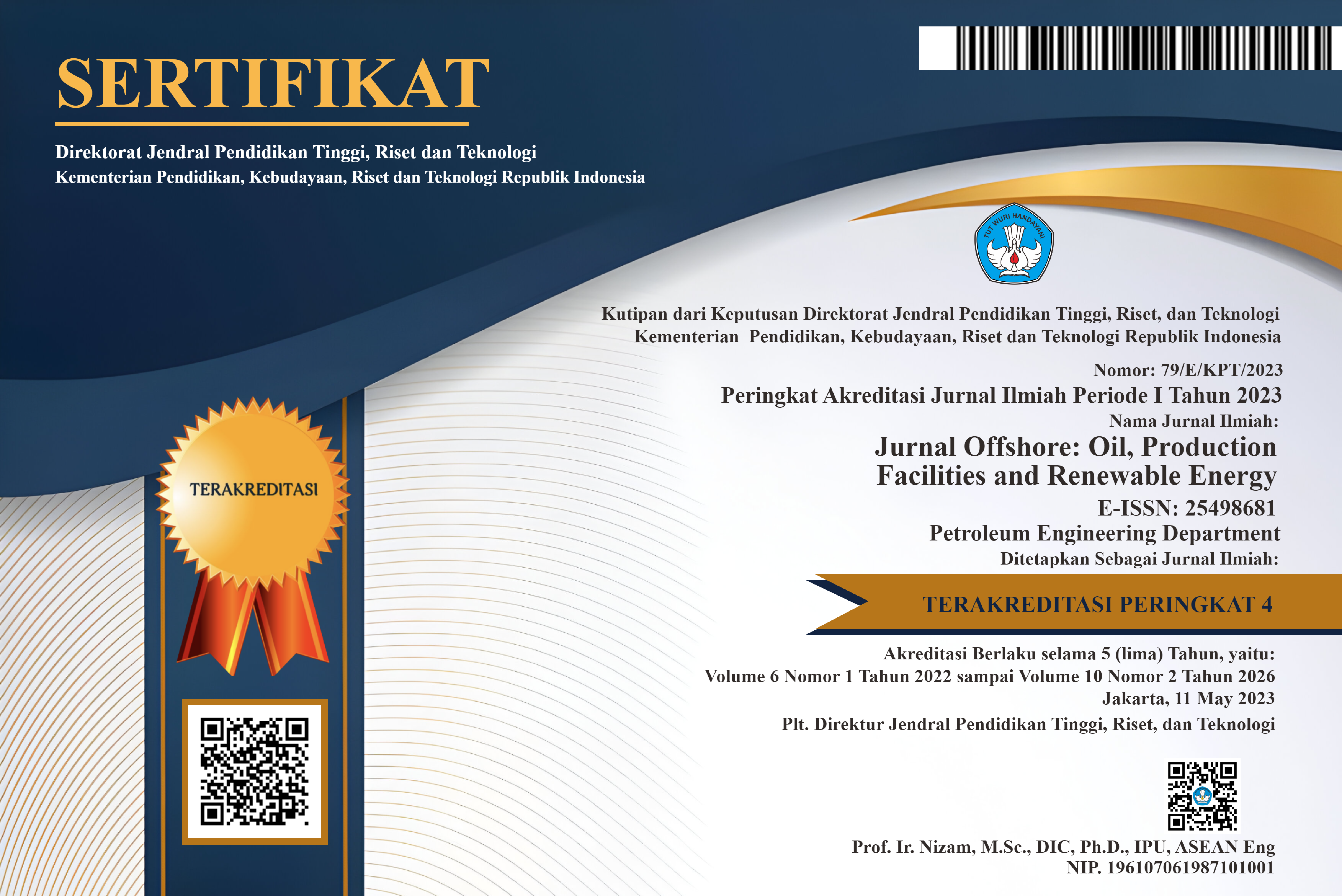Analisa Geoelectrical Strike Metode AMT untuk Identifikasi Awal Potensi Sistem Panas Bumi di Daerah Gunung Pancar Bogor Jawa Barat
DOI:
https://doi.org/10.30588/jo.v3i1.487Keywords:
audio-magnetotelluric, geoelectircal strike, sistem panasbumi, geothermal systemsAbstract
Satu daerah yang diduga terdapat sistem panasbumi adalah daerah Gunung Pancar, Bogor, Jawa Barat. Beberapa mata air panas yang muncul di sekitar daerah penelitian memperkuat dugaan adanya sistem panasbumi di daerah tersebut. Metode geofisika yang dapat digunakan untuk mengidentifikasi sistem panasbumi adalah Metode Audio Magnetotelurik (AMT). Penelitian ini menggunakan metode AMT untuk mendapatkan gambaran bawah permukaan dengan pemodelan 1D dan pemodelan 2D. Pengolahan data dilakukan dengan menggunakan software MT Editor, Interpex, dan Petrel. Geoelectrical strike digunakan untuk mengetahui arah strike bawah permukaan dimana nilai kontras resistivitasnya dapat diindikasikan sebagai gangguan geologi. Data yang digunakan adalah data angle dan radius pada software MT Editor. Sementara software yang digunakan untuk membuat diagram roset adalah software GeoRose. Hasil pemodelan menunjukkan adanya komponen panasbumi berupa claycap (1 Ω.m – 10 Ω.m) dan reservoir (10 Ω.m – 20 Ω.m) pada kedalaman 300 m hingga 2000 m. Lapisan young sedimentary rock diinterpretasikan sebagai zona aliran air panas dengan nilai tahanan jenis sebesar 10 Ω.m – 100 Ω.m. Sistem panasbumi di daerah penelitian diduga dikontrol oleh struktur geologi berupa sesar mendatar, antiklin, dan sinklin yang berkembang di bagian timurlaut daerah penelitian.
The areas that possibly had geothermal system is Mount Pancar, Bogor, West Java. There are several hot springs found around the study area. The geophysical method that can be used to identify the geothermal system and geological structure is the Audio-Magnetotelluric Method (AMT). AMT method is used to obtain subsurface overview with 1D modeling and 2D modeling. Data processing is done by using MT Editor, Interpex, and Petrel software. Geoelectrical strike is used to determine the direction of the subsurface strike by resistivity value. The most dominant angle and radius data from software MT Editor is used to make rosette diagram to show the geoelectrical strike. The results of 1D modeling showed the geothermal component such as claycap (1 Ω.m - 10 Ω.m) and reservoir (10 Ω.m - 20 Ω.m) at a depth of 300 m to 2000 m. The young sedimentary rock layer is interpreted as a discharge zone with a resistance value of 10 Ω.m - 100 Ω.m. The geothermal systems in the study area might be controlled by geological structures in the northeast of the study area.
References
Daud, Yunus., Rosyid, S., Suparno, S., Heditama, D.M., Nuqramadha, W.A., Fahmi, F., Pratama, S.A., Sulistyo, A. 2015. A Student Project Aimed to Investigate the Low to Moderate Temperature Geothermal System in Mt Pancar Area, Bogor (Indonesia) dalam Geophysics Field Camp (GFC). Geothermal Laboratory, Department of Physics, The University of Indonesia. Proceedings World Geothermal Congress.
Guilbert, John M. and C. F. Park, Jr., 1986. The Geology of Ore Deposits. W. H. Freeman.
Khyzhnyak, M., 2014. Geoelectric Strike And Its Application In Magnetotellurics. Faculty of Earth Science: University of Iceland.
Pirajno, F. 1992. Hydrothermal Mineral Deposits, Principles and Fundamental Concepts for the Exploration Geologist. Springer-Verlag. Berlin, Heidelberg, New York, London, Paris.
Simpson, F., dan Bahr, K., 2005. Practical Magne-totellurics. Cambridge University Press.
Unsworth, M., 2013. Theory of Magnetotelluric Over 1D Earth. University of Alberta, Cana
Downloads
Published
How to Cite
Issue
Section
License
Authors retain copyright and grant the Jurnal Offshore right of first publication with the work simultaneously licensed under a Creative Commons Attribution 4.0 International License that allows others to share (copy and redistribute the material in any medium or format) and adapt (remix, transform, and build upon the material) the work for any purpose, even commercially with an acknowledgement of the work's authorship and initial publication in Jurnal Offshore. Authors are able to enter into separate, additional contractual arrangements for the non-exclusive distribution of the journal's published version of the work (e.g., post it to an institutional repository or publish it in a book), with an acknowledgement of its initial publication in Jurnal Offshore. Authors are permitted and encouraged to post their work online (e.g., in institutional repositories or on their website) prior to and during the submission process, as it can lead to productive exchanges, as well as earlier and greater citation of published work (See The Effect of Open Access).















